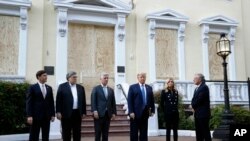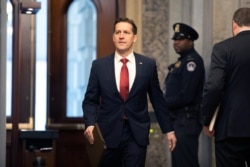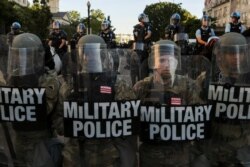The Pentagon is answering criticism following comments by the secretary of defense referring to U.S. protests as a "battlespace" and concern about top Pentagon leaders accompanying the president for a photo opportunity after peaceful protesters were dispersed with tear gas near the White House.
During a White House call to governors about protests across the country Monday, Defense Secretary Mark Esper said, “The sooner that you mass and dominate the battlespace, the quicker this dissipates, and we can get back to the right normal,” according to an audio recording leaked to reporters.
A senior defense official told reporters Tuesday that Esper, who served in a military uniform for more than 20 years, was describing “a relatively unusual activity” for military involvement and used the term “battlespace” because that is the term in which the military frequently uses to talk about an area where troops are operating.
“Nothing should be read into the use of that term to denote anything other than it's the common term we use for the area we are operating in,” the official said on condition of anonymity.
Esper and Gen. Mark Milley, the top U.S. military officer as Chairman of the Joint Chiefs of Staff, have also faced criticism following President Donald Trump’s photo-op Monday in front of St. John’s church, in which a small fire had been set in the basement on Sunday night during protests.
Riot police on Monday forcibly cleared protesters out of Lafayette Square, a public park in front of the White House, before Trump walked through the square with several members of his Cabinet, as well as Milley. The president then stood in front of the historic church posing for photographs with a Bible.
The senior defense official told reporters that neither Esper nor Milley had intended to take part in the photo-op and were actually on their way to the FBI’s Washington field office when they were asked to go to the White House to provide an update to the president.
After the White House meeting, the official said the president “indicated an interest in viewing the troops that were outside, and the secretary and the chairman went with him to do so.”
“They were not aware that the park police and law enforcement had made a decision to clear the square,” the official said. “Their understanding was that they were going out of the White House to go into Lafayette Park to review the efforts to address the protests.”
Jamil Dakwar, director of the ACLU's Human Rights Project, said the use of tear gas on nonviolent protesters was “grossly unjustified use of a dangerous chemical weapon.”
U.S. Sen. Ben Sasse of Nebraska criticized the president for “clearing out a peaceful protest for a photo-op that treats the word of God as a political prop."
And Congressman Bennie G. Thompson, a Democrat from Mississippi who chairs the House Committee on Homeland Security, has sent a letter to the Secret Service director requesting an immediate briefing on the incident.
“It is shameful that the President used the power of the federal government to attack Americans exercising their Constitutional right to protest just so he could stage a photo opportunity,” Thompson wrote.
Law enforcement, troops descend on DC
Incidents of violence were down across the country Monday night, but the number of protesters appeared to stay about the same or increase, National Guard Bureau Chief Gen Joseph Lengyel said.
More than 18,000 National Guardsmen have been deployed to help keep the peace in cities across the country, including in the nation’s capital, Washington, D.C.
Lengyel told reporters nearly 1,300 National Guard members from the D.C. area were helping amid civil unrest, along with help from some Utah and New Jersey Guard members. Tuesday night, an additional 1,500 National Guard members from Indiana, South Carolina and Tennessee will assist D.C. law enforcement.
"The civil unrest mission is … clearly one of our most difficult missions, and frankly, probably the mission that we like doing the least,” Lengyel said.
“As we do domestic operations on a regular basis, whether they're hurricanes or floods or fires, I think this is potentially the most dangerous mission,” he added.
The Department of Defense has upgraded the force protection level in the National Capital Region to include the Pentagon reservation, following days of protests after George Floyd died in Minneapolis while in police custody, chief Pentagon spokesman Jonathan Hoffman said.
The National Capital Region is the only area where the military has moved active-duty service members, in addition to National Guard soldiers or airmen, to potentially help keep the peace. Hundreds of service members arrived Monday at military bases outside of the city and were placed on a shortened alert status if requested and needed, according to officials.
However, at this time, no active-duty members have been deployed to help with the current civil unrest in D.C. or anywhere else in the country.
In addition to the military, specialized teams of federal agents have also been dispatched to help control protests in D.C., which is a federal entity not under the control of any U.S. state.
The Justice Department on Monday deployed personnel in Washington from the FBI, Drug Enforcement Agency, U.S. Marshals Service, Bureau of Prisons, and Bureau of Alcohol, Tobacco, Firearms and Explosives, according to reports.
The Department of Homeland Security also deployed officers from Customs and Border Protection, joining theSecret Service and the Department of the Interior’s U.S. Park Police in response to protests.











